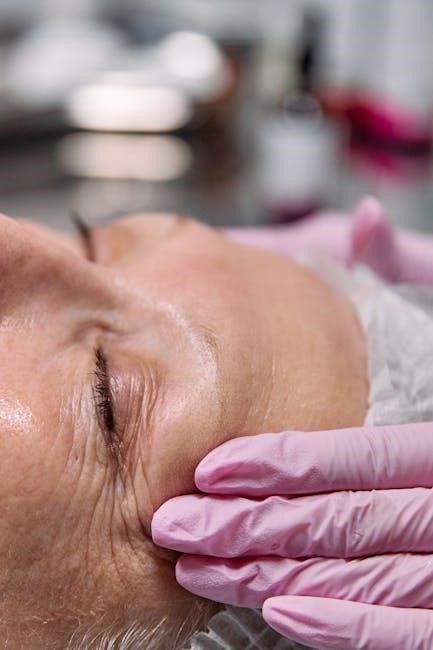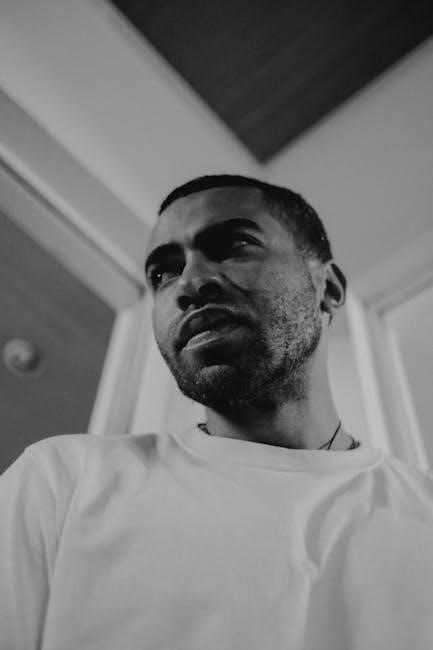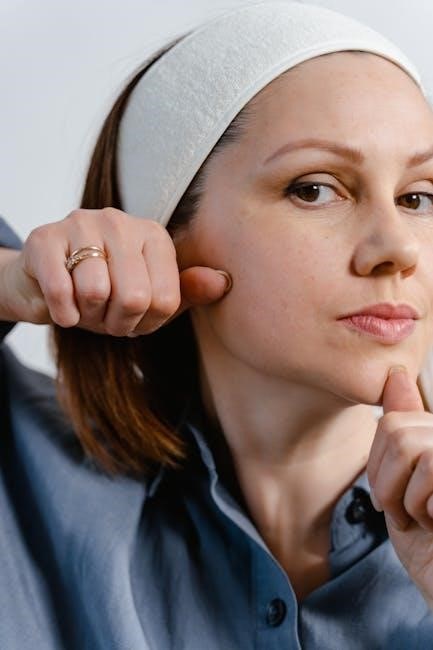Overview of Facial Paralysis
Facial paralysis is a condition that affects the facial nerves, leading to weakness or paralysis of the facial muscles. This can result in difficulty with facial expressions, eye closure, and mouth movements. The condition can be caused by a variety of factors, including injury, infection, or neurological disorders. Facial paralysis can be temporary or permanent, and the symptoms can vary depending on the individual and the underlying cause. A comprehensive understanding of facial paralysis is essential for developing effective treatment and rehabilitation plans, including facial paralysis exercises. Online resources, such as facial paralysis exercises pdf, can provide valuable information and guidance for individuals affected by this condition. By understanding the causes, symptoms, and effects of facial paralysis, individuals can better navigate the treatment process and work towards recovery. Effective management of facial paralysis requires a multidisciplinary approach.
Benefits of Facial Strengthening Exercises
Facial strengthening exercises improve muscle function and overall facial appearance using online resources like facial paralysis exercises pdf every day effectively.
Improving Facial Muscle Strength
Improving facial muscle strength is crucial for individuals with facial paralysis, and can be achieved through regular exercise and therapy. Using online resources such as facial paralysis exercises pdf, individuals can develop a personalized exercise program to target specific muscle groups. The goal of these exercises is to improve muscle function, increase range of motion, and enhance overall facial appearance. By incorporating exercises into their daily routine, individuals can experience significant improvements in facial muscle strength and overall quality of life. Facial paralysis exercises pdf provide a comprehensive guide to getting started with a facial exercise program, including step-by-step instructions and illustrations to help individuals perform exercises correctly and safely. With consistent practice and dedication, individuals can improve facial muscle strength and achieve a more symmetrical and expressive face. Regular exercise can also help prevent further muscle atrophy and promote overall facial health.

Types of Facial Paralysis
Facial paralysis types include congenital and acquired forms, affecting facial nerve function and muscle control, requiring specific exercises and therapy, found in facial paralysis exercises pdf resources online.
Temporary or Permanent Facial Palsy
Facial palsy can be temporary or permanent, depending on the cause and severity of the condition. Temporary facial palsy may resolve on its own with time, while permanent facial palsy requires ongoing management and therapy. The type of facial palsy affects the treatment approach and rehabilitation outcomes. Facial paralysis exercises pdf resources provide valuable information on managing temporary and permanent facial palsy, including exercises and stretches to improve facial muscle function and control. Understanding the differences between temporary and permanent facial palsy is essential for developing effective treatment plans and rehabilitation strategies. By recognizing the characteristics of each type, individuals can better navigate their condition and work towards optimal recovery and management of their facial palsy, using online resources and therapy programmes to guide their progress and improve their quality of life. Facial palsy management requires a comprehensive approach.
Facial Exercise Programmes
Facial exercise programmes involve specific exercises and stretches to improve facial muscle function, using online resources like facial paralysis exercises pdf for guidance and support daily always.
Example of a Facial Exercise Programme
A facial exercise programme typically includes a series of exercises and stretches to improve facial muscle function, such as eye closure and mouth movement exercises. These exercises can be found in online resources like facial paralysis exercises pdf, which provide guidance and support for patients. The programme may involve a combination of massage, warm-up exercises, and specific stretches to target different facial muscles. For example, exercises to improve eye closure may include gently closing the eyes and holding for a few seconds, while exercises to improve mouth movement may include smiling and frowning. The programme should be tailored to the individual’s needs and abilities, and progressed gradually to avoid fatigue and discomfort. By following a facial exercise programme, patients can improve their facial muscle function and overall quality of life, and online resources like facial paralysis exercises pdf can provide valuable support and guidance. Regular practice is essential to achieve optimal results.

Importance of Early Intervention
Early intervention is crucial for effective rehabilitation, using facial paralysis exercises pdf to guide therapy and improve outcomes significantly every day with proper treatment plans.
Starting Exercises within 4 Months of Palsy Onset
Starting exercises within 4 months of palsy onset is essential for optimal recovery, as it helps to improve facial muscle strength and reduce the risk of long-term damage.
Using facial paralysis exercises pdf as a guide, individuals can begin to rebuild their facial muscles and regain control over their facial expressions.
A well-structured exercise programme can help to alleviate symptoms such as facial weakness, drooping eyelids, and difficulty speaking.
It is crucial to work with a healthcare professional to develop a personalized exercise plan that meets individual needs and goals.
By starting exercises early, individuals can improve their chances of making a full recovery and reducing the risk of complications.
Regular exercise and therapy can help to promote healing and restore facial function, enabling individuals to regain their confidence and quality of life.

Role of Physiotherapists in Facial Exercise
Physiotherapists play a crucial role in developing personalized facial exercise programmes using facial paralysis exercises pdf to help patients recover from facial paralysis effectively daily.
Developing a Personalized Exercise Programme
Developing a personalized exercise programme is crucial for effective rehabilitation from facial paralysis. Physiotherapists work closely with patients to create a tailored programme using facial paralysis exercises pdf, taking into account the individual’s specific needs and goals. This programme is designed to improve facial muscle strength, range of motion, and overall function. The physiotherapist will assess the patient’s facial muscles, identify areas of weakness, and develop a programme to target these areas. The programme may include a variety of exercises, such as facial stretches, massages, and strengthening exercises, all of which can be found in facial paralysis exercises pdf. By following a personalized exercise programme, patients can achieve significant improvements in their facial function and overall quality of life, and physiotherapists play a vital role in guiding them through this process. Regular progress monitoring is also essential to adjust the programme as needed.

Additional Resources for Facial Paralysis Exercises
Online resources include facial paralysis exercises pdf and support groups offering guidance and therapy materials for rehabilitation and treatment every day effectively.
Online Resources and Support Groups
Online resources and support groups play a crucial role in providing guidance and therapy materials for facial paralysis exercises. Many websites offer downloadable pdf files containing exercises and treatment plans. These resources can be accessed from anywhere, making it convenient for individuals to follow a rehabilitation program. Support groups, both online and offline, provide a platform for individuals to share their experiences and connect with others who are going through similar challenges. These groups often have experienced therapists and medical professionals who can offer valuable advice and guidance. Additionally, online forums and discussion boards allow individuals to ask questions and receive feedback from others who have undergone similar treatment. Overall, online resources and support groups are essential for individuals seeking to recover from facial paralysis and regain control over their facial muscles. They provide a sense of community and access to valuable information and resources.
